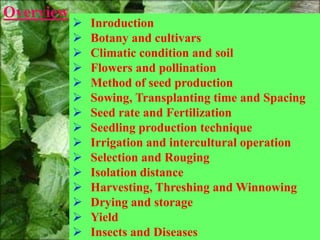Rayo
- 2. Prepared by: Devendra shahu B.Sc.Ag 7th sem Roll .No-17
- 3. Overview ï Inroduction ï Botany and cultivars ï Climatic condition and soil ï Flowers and pollination ï Method of seed production ï Sowing, Transplanting time and Spacing ï Seed rate and Fertilization ï Seedling production technique ï Irrigation and intercultural operation ï Selection and Rouging ï Isolation distance ï Harvesting, Threshing and Winnowing ï Drying and storage ï Yield ï Insects and Diseases
- 4. ïB°ųēđēõēõūąģĶēđ junceae var rugosa, cruciferae ï Nepali name: Rayo saag ïIn Nepal, BLM occupies first position in terms of area and production among leafy vegetables. It is widely adopted and can be grown from Terai to hills of Nepal. It is rich in vitamin A,B,C and iron, calcium and protein. It can be used in lean period by curing and making âGundrukâ. It has high nutrritional and economic importance.
- 5. ïAnnual herb produce large broad leaves. ïIt is also soft leafy vegetables. ï Seed is brown, yellow in colour. Cultivars ïKhumal broad leaf ïMarpha Broad leaf ï Khumal red leaf.
- 6. ïžIt is a cool season crop, so before flowering, it requires cool climate. ïžAt the time of flowering and seed maturation, it requires warm and hot climate. Loamy soil with sufficient humus and high water holding capacity is best for the crop. ïžOptimum pH range for better growth and development should be 6-7.
- 7. ïķ The flower is yellow and the flower is complete containing 6 androecium, 1 gynoecium. ïķAlthough it is cross pollinated crop , from seed production point of view, it is consider as self pollinated crop. ïķIt can be cross pollinated from one variety to another variety but cannot be cross pollinated from one genus to another genus like cauli, turnip,etc.
- 8. Method of seed production Seed to seed method
- 9. ïžAlthough it is a cold season crop, from seed production point of view it can be cultivated from Ashoj in mid-hill and Terai. ïžTransplanting is done in Ashoj-Kartik. Plant growth takes place upto Magh and Bud initiation and flowering takes place in Magh-Falgun. And seed maturation takes place in Baisakh. ïžIn mustang, Transplanting is done in Falgun-Chaitra and seed maturation takes places in Ashar-Shrawan. Spacing Row to row spacing= 75cm. Plant to plant spacing = 45 cm.
- 10. ïķ30 gm seeds/ropani ïķ1500-1800 plants/ropani. ïķPer ropani 1000 kg well rotten FYM, 10 kg complexal and 2 kg MOP should be mixed in soil at the time of land preparation. ïķ4 kg/ropani urea should be required for seed production. ïķ2 kg urea should be applied 40-50 DAT. ïķRemaining 2 kg urea should be top-dressed after bud initiation in the form of ring shape.
- 11. 1. Land should be made clean and dry after tillage opetation. 2. 1 m width, 3m length and 15 cm height raised bed should be made. 3. Line sowing is done. And after sowing, seed is covered with sand and mulching is done with dry straw. 4. Irrigation should be done in every evening time with rose can. 5. After seed germination, straw should be removed. 6. 25-30 Days after germination, Transplanting is done.
- 12. 1) 5 DAT, irrigation with rose can is done. 2) If it is necessary, thereaftere irrigation through irrigation channel is done. 3) 40-45 DAT, Earthing up is done with spade. At this time, top dressed of Urea is done. 4) Second interculture operation is done after initiation of flowering.
- 13. a. Selection and Rouging is done on the basis of foliage characteristics and on the basis of ancestral character. b. Only true to type plants are permitted for flowering which are of qualitatively potential. c. Less qualitative plant like disease plant, damaged plants, insect attack plant, unhealthy plants, etc. are rouged before flowering. d. Maximum permitted off-type for foundation seed is 0.1o % and for certified seed is 0.20 %. e. Minimum no. of field inspection on Rayo is 3. f. 1st at before full grown stage, 2nd at full grown stage in non heading types and 3rd at flowering.
- 14. ïžFor Foundation seed, isolation distance should be 1600 m and for certified seed, it should be 1000 m
- 15. a. Harvesting of plant is done before complete drying of plant when the pod become yellow. b. Plant should be kept in heap in dry shadow place for 3-4 days. c. At 2 days interval, the heap should be aerated by inverted turning of plant in heap. d. Threshing is done either by manual or beating with stick or mechanical method or by any other means. e. The shattered seed should be collected and winnowing should be done.
- 16. 1. The winnowed seed should be sun dried 3-4 times. 2. The moisture percentage should be 6-8 % . 3. The seed should be stored in air tight tin or aluminium container.
- 17. 30-35 kg seed/ropani in context of Nepal. Insects and Diseases Insects; Cutworm, cabbage butterfly, Aphids,etc. Diseases: Damping off, Downy mildew, Leaf spot, White rust , Powdery mildew,etc


















